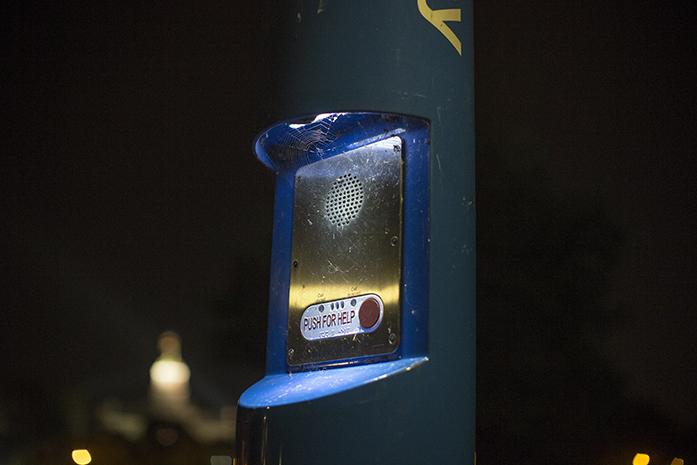Blue emergency phones around the University of Iowa seem to play a secondary role in campus safety.
By Kayli Reese
In the day and age of cellphones, the blue emergency phones, or “blue caps,” on campus still play a role in safety, but not necessarily a large one.
There are currently 24 blue caps on campus, said Jonathan Ron, security division supervisor at the University of Iowa Department of Public Safety. He said cameras are included on 11 of the caps, and all blue caps are tested every week to ensure they are working properly.
“We haven’t had any legitimate calls from blue caps in years,” said UI police Officer Alton Poole, the UI police crime-prevention specialist.
Most calls that have come in, he said, have been false calls; people either have hit the button on the blue caps accidentally or have made a call while drunk.
Poole stressed that people should make common sense decisions when it comes to safety. Many of the blue caps, he said, are located in secluded areas of campus. People instead should, if in a dangerous situation or are if they feel unsafe, go to a more populated area.
The blue caps used to be a great thing, before cellphones became an essential student item, he said. Since 2005, cellphones have been made with GPS included in their features. At the police station, Poole said, an icon will pop up on the map when a person calls 911. From there, an officer can track the location of the person requesting help, even if the person is continually moving.
If blue caps were used instead to call the police, he said, people would have to remain by the blue cap to be found by an officer. Staying in one spot could increase the risk of danger.
“We always look at new technology and options out there,” Ron said, referring to alternatives to the blue caps on campus. While cell phones are currently a great alternative to blue cap use, he said, the department must still consider people who do not have cell phones.
UI freshman Emily Leonhart said she feels safer seeing the blue caps around campus.
Leonhart often walks or runs by herself during various times in the day. She said she usually forgets blue caps are there until she sees one while out.
Leonhart said she would, if ever in a dangerous situation, probably attempt to return to her dorm if at all possible. If she could not return home, she would dial 911 if she was being pursued.
However, she said, if the situation allowed her to stay near a blue cap and remain safe, she would use one.
“I don’t want them to go away,” she said.
Currently, the UI police have no reason to get rid of the blue caps. This can be partly because people feel better at the sight of a blue cap, like Leonhart.
“We have to consider students feeling safe versus being safe,” Poole said.



